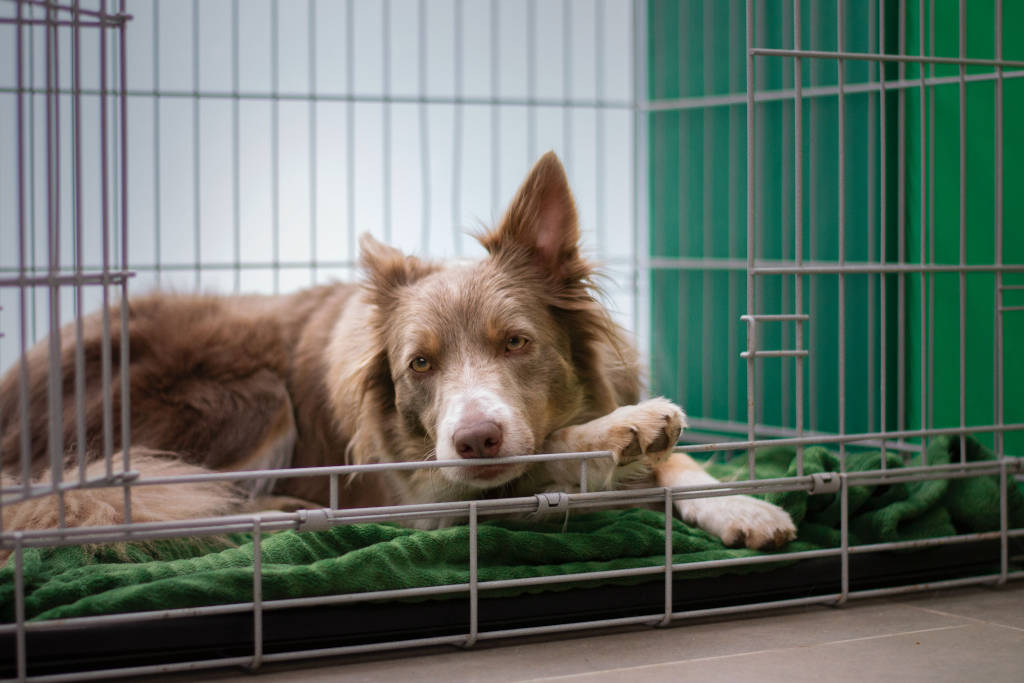A crate is a great tool to use throughout your pet’s life. It’s always a good idea to train your dog to be comfortable being in a crate. It might seem like you don’t need a crate right now, but you might need to board your pet in the future while on vacation, or have your pet stay for a longer visit at the vet’s office. It is a good idea to start crate training now. This will help minimize your pet’s stress levels when they need to be kept in a crate for short periods of time.
Be sure to add a soft towel or blanket to the crate to make it comfortable for your pet. Always use a soothing or nice voice when you’re using the crate. This will help your pet to associate the crate as being a nice and calm place to rest. Place a kong toy with small treats or peanut butter inside the crate. Your pet will start to understand that they get tasty treats when inside their cage.
Keep the crate door open at all times when your pet is relaxing in your home. Leaving the crate door open will hopefully entice your pet to walk in on their own. The goal is for your dog to think the crate is a safe area where they can relax and sleep if they want. Your pet should see the crate as a safe place. It is recommended to keep the crate in an area of your home that you spend a lot of time. The pet will be more enticed to go into the crate if it is in the living room because they can see other family members.
When first starting to crate train, offer your pet’s meals inside the crate. Place their food bowl towards the back of the cage and let your pet walk in on their own. Praise your pet while they are in the cage. Slowly close the door once they are inside the cage. Let your pet finish their meal in the crate and keep them in there for the next 10-15 minutes. While they eat, you can feel free to hang out in the same room or leave the room for a few minutes.
Try a few training sessions throughout the week. Start by tossing a few tasty treats into the crate. Toss the treats toward the back of the crate to entice your pet to walk into the crate on their own. Do not nudge or push your pet into the crate. Let them walk in on their own to get the treat. Let your pet walk into the crate, eat the treat and exit if they wish. Do not reward them when they walk out of the crate. During this training session, we want them to think they get treats only when they are inside the crate. This helps your pet to realize the crate is a safe and good place. Do this training session 10 times, take a short break, and repeat one more round of 10. This will help your pet get used to the crate. Feel free to repeat this process a few times per week until they seem comfortable being in the crate.
When you have to leave your home, you can place a kong filled with peanut butter or small treats in the cage. The kong will keep your pet occupied and distracted as you leave the home. They will also learn that they get super tasty treats while they are calm and inside the crate. Do not make a big fuss when leaving your home. Have your pet walk into the crate 5-10 minutes before you plan to leave. When you leave, feel free to say goodbye, and walk out without a lot of commotion to keep your pet calm. Later, when you return, calmly walk inside your home and let your pet stay in the crate for about 5 minutes as you get settled. The more calm you are and the less you draw attention to the crate, the better your pet will feel in the crate. They will understand that it isn’t a big deal that they are inside the crate.
First, leave your pet in the crate for short periods of time, like 10-15 minutes. Gradually increase the time they are in the crate. For puppies, it is estimated that they can stay in a crate without urinating or defecating for about how many months old the puppy is plus 1. For example, if your puppy is 3 months old, they can stay in the crate for 4 hours maximum. If you are away for the day, it is recommended to have someone stop by and let your pet outside to go to the bathroom.
Although, we don’t want to use the crate as a form of punishment, you can consider placing your pet in their crate if they are getting a little too wild. If your pet is getting rambunctious, starting to nip or bite, or barking and out of control, you can place them gently into the crate. Let them calm down for a few minutes. Only let them out of the crate when they are quiet and calm. Try not to give the pet attention when they are inside the crate. You can also drop a few treats inside. Do not let the pet out when they are whimpering or barking. Make sure your pet is quiet for a few seconds before letting them out. You do not want your pet to learn that when they bark or cry you will let them out.
This information is meant to be used as a guide. Some dogs may take longer to train or have other behavioral issues that can make crate training difficult. Always consult your veterinarian if you have questions about behavior, separation anxiety or health concerns.

